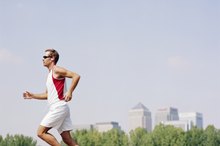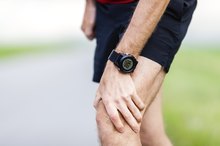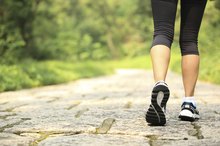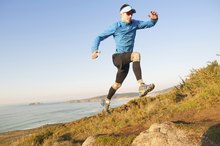Is Running Good or Bad for Back Pain?
Even though running is one of the simplest forms of exercise, each person's body responds differently to it. Running is a high-impact exercise. However, because of differences in stride, weight and coordination, running can be either good or bad for back pain, depending on the individual. If your back pain is chronic or intense, talk to your physician.
Causes of Back Pain
One factor that makes the relationship between running and back pain complex is that there are many causes of back pain. Several structural problems are often the culprits, including bulging or ruptured disks, sciatica, arthritis, skeletal irregularities and osteoporosis. These may only be fixable by surgery, if at all. However, lifestyle risk factors that can cause back pain include obesity, sedentary work and stress.
- One factor that makes the relationship between running and back pain complex is that there are many causes of back pain.
- Several structural problems are often the culprits, including bulging or ruptured disks, sciatica, arthritis, skeletal irregularities and osteoporosis.
How Running Can Cause Back Pain
Running With Kidney Stones
Learn More
Running is a high-impact exercise. The faster you run, the harder your feet hit the ground. The repetitive jarring can be very hard on the joints and the spine. Studies such as the one published in the September 1986 issue of the "British Journal of Sports Medicine" found that the spine shrank by several millimeters after a 6 km run, and the shrinkage was directly proportionate to running speed. Although the relationship of spinal shrinkage to spine pain isn't fully known, those results show how much stress running can put on the spine. If you experience chronic back pain, running may not be an option.
- Running is a high-impact exercise.
- If you experience chronic back pain, running may not be an option.
How Running Can Reduce Back Pain
Running can remedy or reduce some lifestyle causes of back pain. Obesity is a major contributor to back pain, and running is an excellent way to lose weight. A sedentary lifestyle can also cause back pain, by allowing the core muscles that support the spine to lose strength. A study published in the December 2009 issue of "Applied Physiology, Nutrition and Metabolism" found that running activated trunk muscles as well as core-specific exercises. Stress, anxiety and depression are also contributors to back pain, causing the muscles of the lower back to lock up. Exercise is one of the best ways to combat stress.
- Running can remedy or reduce some lifestyle causes of back pain.
- A sedentary lifestyle can also cause back pain, by allowing the core muscles that support the spine to lose strength.
Techniques and Alternatives
How to Run With a Pulled Hamstring
Learn More
Even if you experience back pain during or after running, you might not have to give it up. Spine-Health.com explains that there are several things you can do to minimize or eliminate back pain caused by running. Warm up before your run. Don't take off as fast as you can; walk for awhile and work your way up to speed. Stretch your hamstrings several times throughout the day. The hamstrings can pull at the lower back, causing pain and putting the spine in a suboptimal position to receive the impact of running. Perform weighted core exercises. Wear good, supportive shoes; avoid running on concrete if at all possible. If you have access to a pool, a study published in the July 2011 "American Journal of Physical Medicine and Rehabilitation" found that deep-water running actually significantly reduced pain in patients with chronic back pain by increasing muscular strength and lumbar range of motion.
- Even if you experience back pain during or after running, you might not have to give it up.
- The hamstrings can pull at the lower back, causing pain and putting the spine in a suboptimal position to receive the impact of running.
Related Articles
References
- "Applied Physiology, Nutrition, and Metabolism"; Trunk Muscle Activation During Moderate and High-Intensity Running; D.G. Behm; December 2009
- Spine-Health.com: Running and Lower Back Pain
- "British Journal of Sports Medicine"; Spinal Loading During Circuit Weight-Training and Running; P. Leatt; September 1986
- "American Journal of Physical Medicine and Rehabilitation"; Exercise, Manual Therapy, and Education With or Without High-Intensity Deep-Water Running for Nonspecific Chronic Low Back Pain; A.L Cuesta-Vargas; July 2011
- Lopes AD, Costa LO, Saragiotto BT, Yamato TP, Adami F, Verhagen E. Musculoskeletal pain is prevalent among recreational runners who are about to compete: an observational study of 1049 runners. J Physiother. 2011;57(3):179-82. doi:10.1016/S1836-9553(11)70039-X
- Bonasia DE, Rosso F, Cottino U, Rossi R. Exercise-induced leg pain. Asia Pac J Sports Med Arthrosc Rehabil Technol. 2015;2(3):73-84. doi:10.1016/j.asmart.2015.03.003
- Wilcox CE, Mayer AR, Teshiba TM, et al. The subjective experience of pain: An FMRI study of percept-related models and functional connectivity. Pain Med. 2015;16(11):2121-33. doi:10.1111/pme.12785
- Hullfish TJ, Hagan KL, Casey E, Baxter JR. Achilles tendon structure differs between competitive distance runners and nonrunners despite no clinical signs or symptoms of midsubstance tendinopathy. J Appl Physiol. 2018;125(2):453-458. doi:10.1152/japplphysiol.00012.2018
- Linton L, Valentin S. Running with injury: A study of UK novice and recreational runners and factors associated with running related injury. J Sci Med Sport. 2018;21(12):1221-1225. doi:10.1016/j.jsams.2018.05.021
- Davis IS, Futrell E. Gait retraining: Altering the fingerprint of gait. Phys Med Rehabil Clin N Am. 2016;27(1):339-55. doi:10.1016/j.pmr.2015.09.002
- Gallo RA, Plakke M, Silvis ML. Common leg injuries of long-distance runners: anatomical and biomechanical approach. Sports Health. 2012;4(6):485-95. doi:10.1177/1941738112445871
- Quah JL, Yap S, Cheah SO, et al. Knowledge of signs and symptoms of heart attack and stroke among Singapore residents. Biomed Res Int. 2014;2014:572425. doi:10.1155/2014/572425
- Nichols AW. Heat-related illness in sports and exercise. Curr Rev Musculoskelet Med. 2014;7(4):355-65. doi:10.1007/s12178-014-9240-0
- Chang WD, Lin HY, Lai PT. Core strength training for patients with chronic low back pain. J Phys Ther Sci. 2015;27(3):619-22. doi:10.1589/jpts.27.619
- Kunene SH, Ramklass S, Taukobong NP. Anterior knee pain and its intrinsic risk factors among runners in under-resourced communities in Ekurhuleni, Gauteng. S Afr J Physiother. 2018;74(1):452. doi:10.4102/sajp.v74i1.452
- Brewer RB, Gregory AJ. Chronic lower leg pain in athletes: a guide for the differential diagnosis, evaluation, and treatment. Sports Health. 2012;4(2):121-7. doi:10.1177/1941738111426115
- Mellinger S, Neurohr GA. Evidence based treatment options for common knee injuries in runners. Ann Transl Med. 2019;7(Suppl 7):S249. doi:10.21037/atm.2019.04.08
- Hatzigeorgiadis A, Zourbanos N, Galanis E, Theodorakis Y. Self-talk and sports performance: A meta-analysis. Perspect Psychol Sci. 2011;6(4):348-56. doi:10.1177/1745691611413136
- Cantwell JD. Cardiovascular aspects of running. Clin Sports Med. 1985;4(4):627-40.
- National Institutes of Health. NIH Osteoporosis and Related Bone Diseases National Resource Center. Exercise for Your Bone Health. Updated October 2018.
- Guiney H, Machado L. Benefits of regular aerobic exercise for executive functioning in healthy populations. Psychon Bull Rev. 2013;20(1):73-86. doi:10.3758/s13423-012-0345-4
- Hoveida R, Alaei H, Oryan S, Parivar K, Reisi P. Treadmill running improves spatial memory in an animal model of Alzheimer's disease. Behav Brain Res. 2011;216(1):270-4. doi:10.1016/j.bbr.2010.08.003
- Kalak N, Gerber M, Kirov R, et al. Daily morning running for 3 weeks improved sleep and psychological functioning in healthy adolescents compared with controls. J Adolesc Health. 2012;51(6):615-22. doi:10.1016/j.jadohealth.2012.02.020
- Zamani sani SH, Fathirezaie Z, Brand S, et al. Physical activity and self-esteem: testing direct and indirect relationships associated with psychological and physical mechanisms. Neuropsychiatr Dis Treat. 2016;12:2617-2625. doi:10.2147/NDT.S116811
- Boecker H, Sprenger T, Spilker ME, et al. The runner's high: opioidergic mechanisms in the human brain. Cereb Cortex. 2008;18(11):2523-31. doi:10.1093/cercor/bhn013
- Boecker H, et al. The Runners High: Opioidergic Mechanisms in the Human Brain. Cerebral Cortex. 2008;18(11):2523-2531. doi:10.1093/cercor/bhn013.
- Fernandes MFA, et al. Leptin Suppresses the Rewarding Effects of Running via STAT3 Signaling in Dopamine Neurons. Cell Metabolism. 2015;22(4):741-749. doi:10.1016/j.cmet.2015.08.003
- Guiney H, Machado L. Benefits of regular aerobic exercise for executive functioning in healthy populations. Psychonomic Bulletin & Review. 2012;20(1):73-86. doi:10.3758/s13423-012-0345-4.
- Kalak, N, et al. Daily Morning Running for 3 Weeks Improved Sleep and Psychological Functioning in Healthy Adolescents Compared With Controls. Journal of Adolescent Health. 2012;51(6):615-622.
- Mota MR, et al. Effects of treadmill running and resistance exercises on lowering blood pressure during the daily work of hypertensive subjects. Journal of Strength & Conditioning Research. 2009
- Nokia, MS, et al. Physical Exercise Increases Adult Hippocampal Neurogenesis in Male Rats Provided it is Aerobic and Sustained. J Physiol. 2016; 594: 1855-1873. doi: 10.1113/JP271552.
- Otto MW, Smits JAJ. Exercise for Mood and Anxiety, Proven Strategies for Overcoming Depression and Enhancing Well-Being. Oxford University Press. 2011.
- Sani SHZ, et al. Physical activity and self-esteem: testing direct and indirect relationships associated with psychological and physical mechanisms. Neuropsychiatric Disease and Treatment. 2016;Volume 12:2617-2625. doi:10.2147/ndt.s116811.
- Venckunas, T, Kamandulis, S. Interval Running Training Improves Cognitive Flexibility and Aerobic Power of Young Healthy Adults. Journal of Strength and Conditioning Research. 2016; 30(8): 2114-212. doi: 10.1519/JSC.0000000000001322.
Writer Bio
Martin Booe writes about health, wellness and the blues. His byline has appeared in the Washington Post, the Los Angeles Times and Bon Appetit. He lives in Los Angeles.









